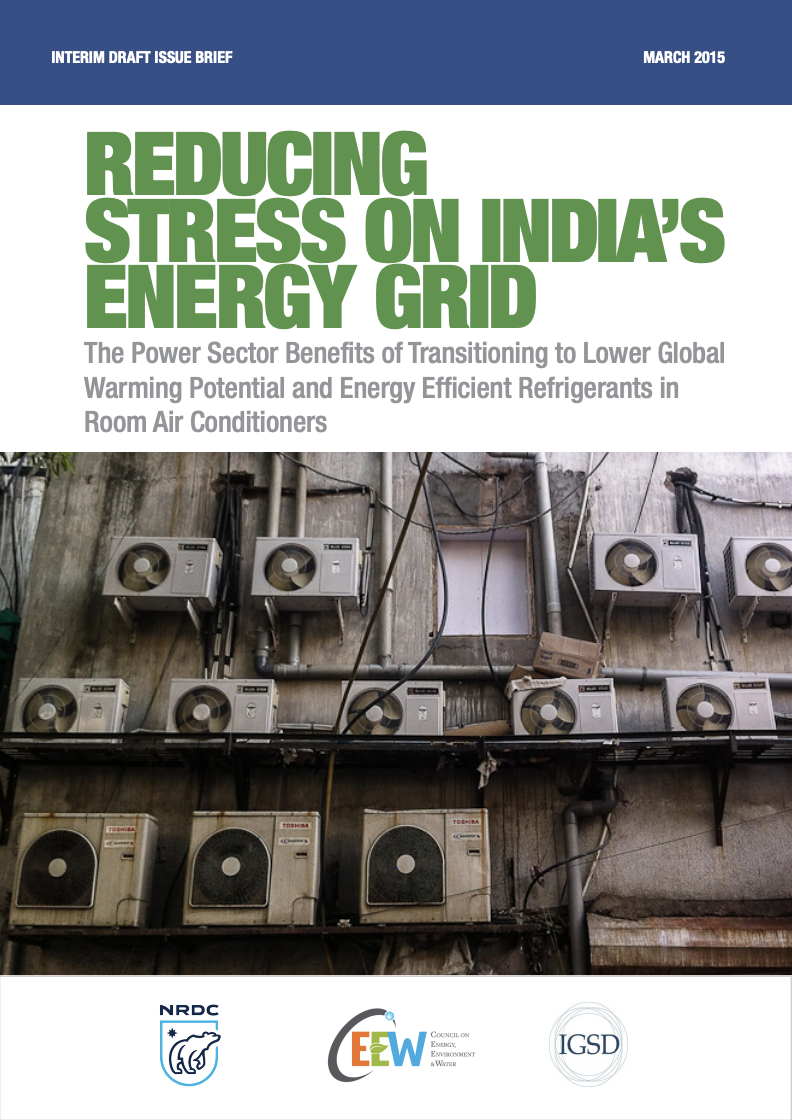Issue Brief
Reducing Stress on India’s Energy Grid
Benefits of Transitioning to Lower Global Warming Potential and Energy Efficient Refrigerants in Room Air Conditioners
Shannon Dilley, Arunabha Ghosh, Anjali Jaiswal, Vaibhav Chaturvedi, Bhaskar Deol
March 2015 |
Suggested Citation: NRDC-CEEW-IGSD. 2015. Reducing Stress on India’s Energy Grid: The Power Sector Benefits of Transitioning to Lower Global Warming Potential and Energy Efficient Refrigerants in Room Air Conditioners. New York: Natural Resources Defence Council.
Overview
This issue brief, in collaboration with the National Resources Defense Council, explores the potential of sustainable cooling to strengthen India’s power sector and tackle climate change. It focuses on leapfrogging and phasing down unsustainable technologies based on chemicals with high global warming potential (GWP). Further, it recommends ways to move to a future based on climate-friendly and energy-efficient refrigerants.
Key Findings
- China, Japan, Indonesia, and the European Union are seeing rapid adoption of alternative refrigerants that are more efficient and cause less global warming.
- Energy requirements for cooling buildings will grow faster than any other energy demand in the Indian building sector.
- Estimates suggest that ACs will account for 46 gigawatts (GW) of peak energy demand by 2020 and 143 GW by 2030.
- The refrigerant used in India’s room ACs, HCFC-22, is scheduled for phase-out under the Montreal Protocol. India plans to phase out HCFC-22 by 10 per cent in 2015, 35 per cent by 2020, 67.5 per cent by 2025, and 97.5 per cent by 2030.
- Room ACs that use lower-GWP refrigerants can provide greater energy efficiency while providing a thermodynamic advantage by improving performance at high ambient temperatures.
- Several alternative blends are emerging as the leading alternatives – R-290 and R-32.
- Both R-290 and R-32 models have higher energy efficiency ratings available and perform better at high ambient temperatures typical in India.
- According to the EU, R-290-based room, ACs could save 11.9 GW hours a month over room ACs using HFC-410a. They are seen as a good fit for Indian ACs because of high ambient temperatures.
- It is estimated that R-32 would reduce greenhouse gas emissions by 31 per cent by 2050. Half of this reduction would come from energy efficiency and the other half from direct emissions reductions.
- By successfully phasing out CFCs, India is viewed as a leader in restoring the stratospheric ozone layer. Earlier, India was the second-largest producer of CFCs in the world.
Key Recommendations
- Indian market should start adopting more energy-efficient and climate-friendly refrigerant alternatives with financing from the Montreal Protocol Multilateral Fund.
- International expertise should help establish the infrastructure to make the transition along with training and insights on the best technologies available.
- Indian market should avoid higher costs of transitioning later and gain greater access to domestic and foreign markets moving away from HFCs.
- Take advantage of an emerging market, prevent a major share of future climate-changing emissions before they even occur, and help India meet its energy needs.
Room ACs that use lower-GWP refrigerants can provide greater energy efficiency while providing a thermodynamic advantage by improving performance at high ambient temperatures.





